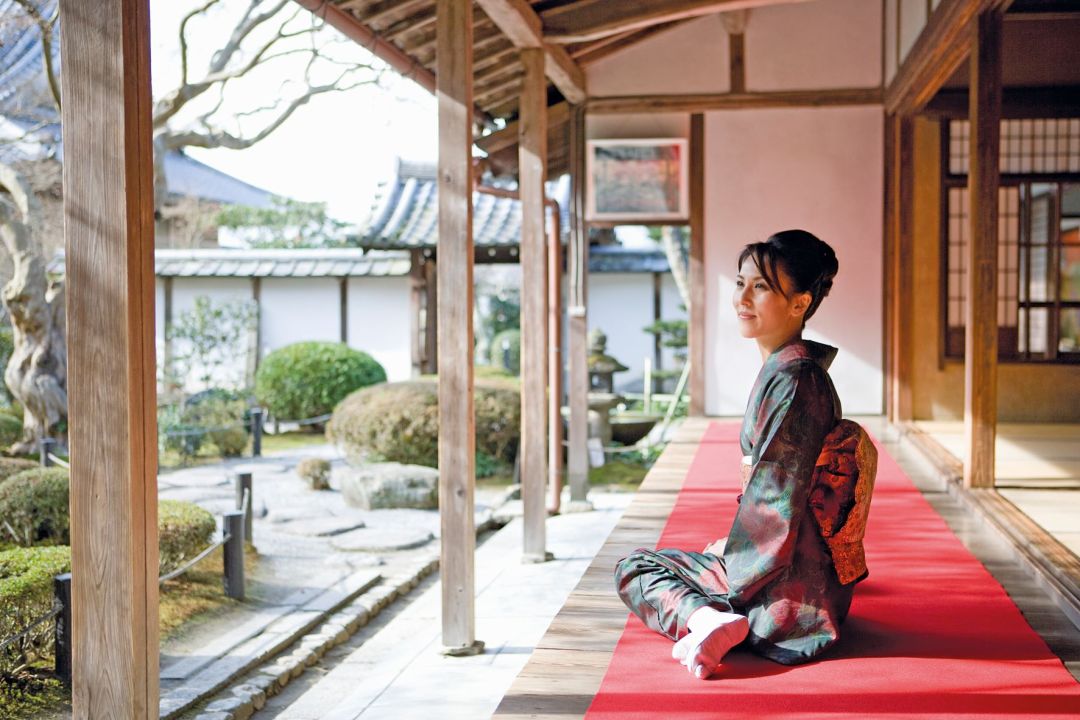Japanese wellness practices: ikigai, wabi sabi & kintsugi
In our quest to discover the best wellbeing tips from around the globe, this month we’re embracing Japanese wellness practices - also known as J-wellness - to discover how the concepts of ikigai, wabi sabi and kintsugi could help us all lead a longer, healthier and more fulfilling life...

From the simple pleasures of hygge to the ‘just enough’ of lagom, we’ve been busy gobbling up Nordic wisdom from the world’s happiest countries over the past couple of years. But while our Scandinavian cousins have lots to share, over in Japan they also know a thing or two about living well, with more than 65,000 centenarians among their population. Women in Japan live healthily and independently for longer than anywhere else in the world. In the mountain region of Nagano, average female life expectancy is almost 88 years. So, what can we learn from Japanese wellness practices?
Diet is one factor – in Japan, the average person eats more than 100kg of vegetables per year, and Nagano’s inhabitants eat more plant-based foods than anyone else in the country. But could the way they see the world be just as important? ‘I strongly believe that a certain Japanese frame of mind is connected to the nation’s health and longevity,’ says Tokyo-based artist David Buchler, co-author of Ikigai & Other Japanese Words to Live By (£12.99, Modern Books).
The teachings of Zen Buddhism and Shinto
The Japanese perspective is underpinned by the teachings of Zen Buddhism and Shinto. Zen centres on mindfulness, meditation an dintuition. ‘Japanese people have a remarkable ability to block out the world around them,’ David says. ‘Rush hour on a Tokyo train is absolutely silent. People use the time to rest and focus on themselves.’
Shinto, Japan’s indigenous religious tradition, venerates nature. We know that taking a few minutes to meditate or immerse ourselves in nature – a.k.a. shinrin-yoku, or forest bathing – can improve your health and wellbeing, boosting mood and immunity. But what might we learn from bringing the two together?

Learn to embrace imperfection
Becoming more mindful of our connection with, and place in, nature can unlock the sense of calm serenity we associate with Zen. ‘Nothing in nature is perfect, complete or immortal,’ explains Mari Fujimoto, David’s co-author from City University, New York. ‘We need to break the habit of only valuing the things we typically categorise as ‘good’, such as perfection, beauty and youth, and frowning upon ‘bad’ things such as imperfection, ugliness and ageing.’
And we needn’t just learn to accept these things, as our understanding of mindfulness might have us believe. Instead, we can learn to appreciate the beauty, character and story behind any imperfection, and welcome the growth, development and change that comes with it.
‘The traditional view in Japan is that people are part of nature, not separate from it,’ says life coach and specialist in the study of Japan, Beth Kempton, who is also the author of Wabi Sabi: Japanese wisdom for a perfectly imperfect life (£6.49, Piatkus). Ancient Japanese teachings say perfection, completion and permanence are neither possible nor desirable, since they leave no room for growth. ‘That core teaching – that everything is impermanent, imperfect and incomplete – is a giant permission slip to explore and experiment,’ says Beth. ‘Change is inevitable – be open to it.’
‘We need to break the habit of only valuing the things we typically categorise as ‘good’, such as perfection, beauty and youth, and frowning upon ‘bad’ things such as imperfection, ugliness and ageing.’ – Mari Fujimoto
Learning to cherish nature, and to see beauty in imperfection, helps to cultivate a sense of active purpose, which is thought to be a key driver of Japanese longevity. So while hygge might have had you snuggling by a roaring fire, the act of fetching in the logs is just as valuable.
Japanese people don’t talk about retiring, either: many people work into their nineties, Nagano has the highest rate of ‘elderly occupation’ in the country, and centenarians will happily share their ikigai – or reason for living –with you. ‘The Japanese language has so many beautiful words,’ Beth adds. ‘They give us a way to say something we instinctively know but have never had a word for. I hope that by explaining them, we make this wisdom more accessible.’
Read on to discover more about these Japanese wellness – or J-wellness – practices and concepts and how they can help you…

What is ikigai?
Simply put, your ikigai is your reason for living. It’s the sense of purpose that motivates Japanese centenarians to stay active and well. ‘It makes you happy, makes you smile, makes you get up in the morning and keeps you going every day,’ explains Mari. ‘It can be a hobby, your family or your job. Each person’s ikigai is unique. Mine is seeing my children smile, but yours could be gardening, yoga, patchwork or your daily walk.’
How to find your ikigai
Your ikigai can change and evolve over time, be a lifelong project, or the sum of lots of small, everyday joys. Not sure what yours is? That’s normal. ‘It might be worth turning off your phone and computer, then physically writing a list of everything that makes you feel good,’ says Mari.
Add everything you can think of that has made you smile, lose track of time or feel positive, motivated or excited. Then, make a list of things that make you feel down, lonely, uncomfortable or sad. ‘Once you’re done, leave them alone for a while, then look at them again. You may find something in what you have written that you didn’t notice before,’ she says.
‘Learn to look beyond yourself and your ikigai will slowly reveal itself over time.’ – David Buchler
Meditation can also help you discover your ikigai. ‘When you give yourself time to clear your mind and become aware of what’s most important – and not important – you will more easily be able to see your ikigai,’ says Mari. Spending time in nature is also a good idea, suggests David. ‘Acknowledging its transience is restorative,’ he says. ‘Learn to look beyond yourself and your ikigai will slowly reveal itself over time.’

What is wabi sabi?
Deeply etched on Japanese hearts and minds is the concept of wabi sabi: ‘wabi’ meaning appreciating beauty in simplicity, and ‘sabi’ being about the transience of that beauty and the changeable nature of life. It is often thought of as an appreciation of imperfection only. However, this is apparently a common western misinterpretation, and more to do with kintsugi, according to Beth.
‘Wabi sabi is really an intuitive, visceral response to “authentic beauty”. Something all the more beautiful for its transient, unrefined nature: a falling cherry blossom, a haunting melody, a kiss,’ says Beth. ‘It varies from person to person because we are all moved by different things.’
How to incorporate wabi sabi into your life:
Wabi sabi can help you to live a less cluttered, more simple life, too. ‘Learning to recognise wabi sabi has helped me tune in to the marvel that is life,’ Beth says. ‘It feels like permission to take things more easily, let some things go and spend more time on things that really matter. I feel calmer, more appreciative and present in relationships and conversations. And, I no longer want to accumulate stuff, which has saved me a fortune!’
Living the wabi sabi way is part of an ongoing process Beth calls ‘soulful simplification’. Creating space in your mind, life and home creates space to experience wabi sabi. Meditation is a good starting point. ‘When you practice mindfulness, and slow down enough to notice the beauty all around you, you are more likely to experience wabi sabi,’ says Beth.
‘Give yourself more time with nature and try to live in closer rhythm with the seasons.’ That might mean sourcing locally grown, seasonal produce or having a go at flower arranging. Ask yourself, ‘what kind of beauty can you create?’
DID YOU KNOW? Ikebana, the art of ‘giving life to flowers’, is a mindful practice. Japanese flower arrangements are asymmetrical, representing nature’s imperfect beauty.

What is kintsugi?
When a piece of pottery breaks, Japanese artisans don’t try to hide the cracks – they celebrate them. Kintsugi, the art of golden joinery, uses gold dust, resin and lacquer to create a unique pattern of golden cracks. It’s a bold illustration of resilience, strength and beauty in imperfection, and a useful metaphor for human healing.
‘Your scars mean you have become stronger through adversity,’ explains psychologist Tomás Navarro, author of Kintsugi: Embrace your imperfections and find happiness – the Japanese way (14.99, Yellow Kite). ‘Many people come to me saying their heart, their life or their dreams are broken, so I thought I could use kintsugi to work on these broken pieces.’
How to learn from kintsugi and embrace your own ‘cracks’:
Reframing the story behind your own ‘cracks’ and imbuing them with a sense of meaning can bolster your resilience. ‘Don’t rush. You need time to repair and recover perspective when things have gone wrong,’ says Tomás. Get some distance, and then reassess what happened. ‘when you are in the eye of the storm, you make mistakes in your conclusions,’ he explains.
‘It’s easy to feel guilt or shame for something that was just an accident or bad luck. put what happened into context and try not to personalise or dramatise it. If you can learn from it, it hasn’t been in vain.’ The lesson is to appreciate the opportunities provided by failures and setbacks and, ultimately, not to view them in a negative way.
‘Your imperfections are the golden glue that makes you strong, unique and beautiful: celebrate them.’ – Tomás Navarro
‘Don’t be afraid of pain. Life should be lived intensely,’ Tomás urges. ‘We have everything we need to deal with adversity, but fear of failing often limits us. We need to make mistakes in order to learn.’ It’s the hiccups, knocks and scrapes we encounter along the way that allow us to grow. Your imperfections are the golden glue that makes you strong, unique and beautiful: celebrate them.’
Kintsugi was invented when 15th-century Japanese shogun Ashikaga Yoshimasa refused to accept that his favourite teacup was broken beyond repair.
Words: Samantha Simmonds | Photos: Getty Images









